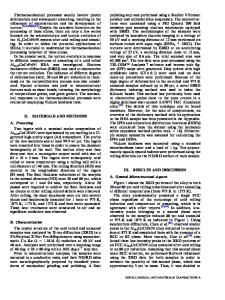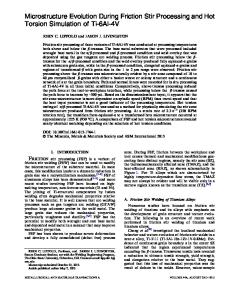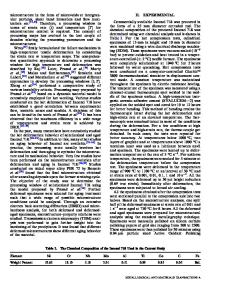Microstructure Evolution and Composition Control During the Processing of Thin-Gage Metallic Foil
- PDF / 2,270,926 Bytes
- 16 Pages / 593.972 x 792 pts Page_size
- 21 Downloads / 296 Views
UCTION
HONEYCOMB and truss-core products made from thin-gage sheet and foil are used for a variety of applications requiring characteristics such as light weight, high structural stiffness, and low thermal conductivity. Ductile, low-temperature metals such as aluminum and low-carbon steel are readily produced in thin gages via ingot-metallurgy approaches consisting of successive hot- and cold-working operations to produce billet/bloom, plate, sheet, and foil with or without intermediate annealing steps. By contrast, the wrought manufacture of high-temperature, difficult-towork materials such as nickel-base superalloys and intermetallic alloys can be substantially more challenging and costly due to a narrow processing window, the need for numerous intermediate anneals when using cold rolling to produce final gage, and low product yield. In extreme cases, such as the production of intermetallic gamma-titanium-aluminide foil, limited
S.L. SEMIATIN, Senior Scientist, Materials Processing/Processing Science, and D.L. BALLARD, Senior Materials Research Engineer, are with the Air Force Research Laboratory, Materials and Manufacturing Directorate, AFRL/RXLM, Wright-Patterson Air Force Base, OH 45433-7817. Contact e-mail: [email protected] M.E. GROSS, Senior Scientist/Program Manager, D.W. MATSON, Senior Scientist, W.D. BENNETT, Scientist, and C.C. BONHAM, Technologist, are with Pacific Northwest National Laboratory, Energy and Environment Directorate, Richland, WA 99354. A.I. USTINOV, Head of the Department of Vapor-Phase Technologies of Inorganic Materials, is with the E.O. Paton Electric Welding Institute of the National Academy of Science of Ukraine, Kiev 03680, Ukraine. Manuscript submitted November 29, 2011. METALLURGICAL AND MATERIALS TRANSACTIONS A
workability necessitates that all processing be done at hot-working temperatures via methods such as hot-pack rolling.[1,2] In turn, pack rolling of thin-gage products introduces stringent requirements related to pack design, can materials, and parting agents, each of which may affect reduction uniformity, surface finish, and thermal stress development/fracture during cooldown. As an alternative to multistep wrought processing, vapor-phase methods may enable the direct production of thin-gage foil. In this regard, two methods are promising: magnetron sputtering (MS) and electronbeam physical vapor deposition (EBPVD). MS yields relatively slow deposition rates of the order of 0.1 to 5 lm/hours. It has been used at a laboratory scale to make small coupons of various gamma titanium aluminide alloys. For example, Abe et al.,[3] Banerjee et al.,[4] and Senkov et al.[5,6] used MS onto ambienttemperature silicon or copper substrates to produce binary c-TiAl or various quaternary and quinary alloys. The thickest samples (albeit of small plan-view area) were made by Senkov et al. who produced free-standing foil using a polished, water-cooled copper substrate. In most cases, the sputtering process led to an essentially amorphous deposit, which can be ascribed to the use of the lo
Data Loading...











